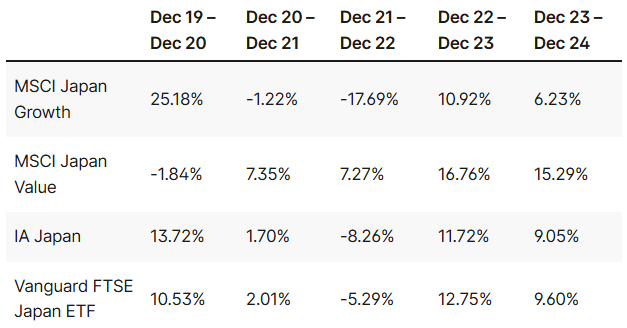Written by: Danielle Farley | Hargreaves Lansdow
2024 was an eventful year.
There was lots of political change with around half the world’s population heading to the polls.
Central banks in most countries started to cut interest rates, although there were less cuts than predicted.
And among all of this, geopolitical tensions around the world continued, which brought its fair share of uncertainty.
Despite the economy proving to be more resilient than expected and global stock markets performing well in 2024, there were plenty of ups and downs along the way.
This gave active investing fund managers a lot to think about during the year. And while there were opportunities for them to capture, there were also plenty of challenges.
Active fund managers struggled to beat some areas of the market in 2024, and in these areas passive funds outperformed.
Here’s a look at the areas where passive investing did best.
Remember, one year is a short timeframe to look at performance and investments should be held for the long term – usually for five years or more.
This article isn’t personal advice. If you're not sure if an investment is right for you, ask for financial advice. All investments and any income from them can rise and fall in value, so you could get back less than you invest. Past performance isn’t a guide to the future.
US and Global
Active funds in the US and global sectors struggled to outperform the market in 2024 as mega-cap technology companies, like the ‘Magnificent Seven’, dominated market returns. This was driven by significant advancements in artificial intelligence (AI).
The ‘Magnificent Seven’ make up almost a third of the S&P 500 index and just under one fifth of the FTSE All-World index. Active funds are likely to have less invested in this group of companies as their aim is to beat the index, rather than simply replicate it.
When an index is concentrated and companies that make up the largest part of the index perform very strongly, like they did in 2024, it’s difficult for active funds to compete.
One of the ways you can assess a fund’s performance is by comparing it to the average performance of all the funds in its sector.
Over the past year, the IA North America sector average returned 22.15%* versus 26.91% for a passive ETF that tracks the US market (the Vanguard S&P 500 ETF).
The difference between the sector average and a passive ETF was bigger for the global sector, with the IA Global peer group average returning 12.49% compared to 19.28% for the Vanguard FTSE All-World ETF.
Annual percentage growth

Past performance isn't a guide to future returns.
Source: *Lipper IM, to 31/12/2024.
Emerging markets
China has been a difficult place for investors in recent years. Its economy hasn’t recovered as many had expected since its COVID-19 lockdown and there have been ongoing concerns around its property sector.
But the Chinese stock market rallied in the second half of 2024 when the government announced stimulus measures aimed at boosting its economy.
Active fund managers have mixed views on China. Some are more cautious and would rather focus on other emerging markets like India, while others are still finding good opportunities there.
As China makes up just under a third of the FTSE Emerging Index, it has a big impact on overall returns, and it was a tricky area for active fund managers to navigate.
Over the year, the IA Global Emerging markets sector average gained 8.21%* versus 14.07% for the Vanguard FTSE Emerging Markets ETF. But if you look at the table below, you can see that the sector average has been higher than the returns of this passive ETF in previous years.
Emerging markets offer lots of opportunity for active funds managers, though they're higher risk and typically more volatile than developed markets.
Annual percentage growth

Past performance isn't a guide to future returns.
Source: *Lipper IM, to 31/12/2024.
Japan
The ‘growth’ style of investing was in favour in most markets in 2024 as high growth companies, like the ‘Magnificent Seven’ and ones in the technology sector, performed strongly.
The exception to this was in Japan where there were many opportunities for ‘value’ focused investors who aim to buy companies for less than they’re worth.
The MSCI Japan Growth Index rose 6.23%* over the year compared to 15.29% for the MSCI Japan Value Index.
Japan’s economy is different to most others. The Bank of Japan raised interest rates in 2024 for the first time since 2007, and Japan became the last country in the world to end negative rates.
Active managers fared better in this part of the market in 2024 compared to other sectors, with ‘value’ funds more likely to outperform.
During this time, the IA Japan sector average and Vanguard FTSE Japan ETF returned 9.05% and 9.60% respectively.
Annual percentage growth

Past performance isn't a guide to future returns.
Source: *Lipper IM, to 31/12/2024.
What does this mean for portfolios?
Although tech companies performed very well in 2024, this won’t be the case every year as different sectors come in and out of favour. That’s why we believe it’s important for long-term investors to maintain diversified portfolios across different regions, sectors and styles of investing.
Investors can use both active and passive approaches in their portfolios, depending on what’s most appropriate for a particular area of the market or style of investing.
IA sectors include lots of different funds and the average doesn’t represent every fund in the sector. The worst performing funds will bring the sector average down. So, when choosing active funds, it’s important to look for experienced fund managers with long track records of performance (at least five years, but ideally ten).
Related: Rethinking Long-Term Investments: Are Stocks Always Best?


